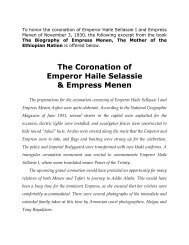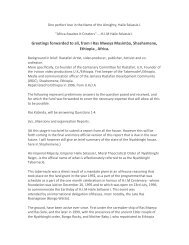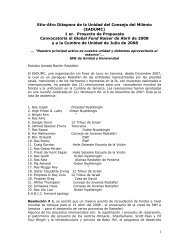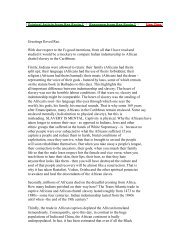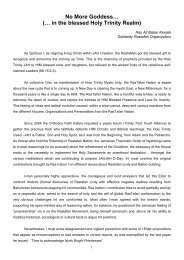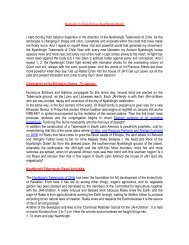DRAFT Universal Hair Exemption Letter TO: United ... - RasTa Ites
DRAFT Universal Hair Exemption Letter TO: United ... - RasTa Ites
DRAFT Universal Hair Exemption Letter TO: United ... - RasTa Ites
You also want an ePaper? Increase the reach of your titles
YUMPU automatically turns print PDFs into web optimized ePapers that Google loves.
Through cranio-facial hair presentation, people symbolize their identities with respect to a<br />
wide range of phenomena: religious, political, sexual, social, occupational and others.<br />
(Synnott, 1987 at pg. 405)<br />
Males express their ideologies and status in their hair. (Synnott, 1987 at pg. 397) .... In<br />
this day, long hair and facial hair are often seen to be symbolic of ideological opposition<br />
to "the establishment." (Synnott, 1987 at pg. 401) The allowance of facial hair by the<br />
male represents his manhood in that it differentiates him from females and children.<br />
(Synnott, 1987 at pg. 390)<br />
Why do those in authority want men to shave their faces and cut their cranial hair short?<br />
It has been posited that the hair of prison inmates and soldiers is kept cut as a reminder<br />
that "you are not a free person and cannot do as you please with your own body."<br />
(Rabinowitz, 1984) Shaving produces effects like other means of fostering a youthful<br />
appearance because a "clean-shaven" face mimics the surface quality of the pre-pubertal<br />
face. (Guthrie, 1976 at pg. 30) Therefore, requiring a man to shave can have the effect of<br />
reducing his status, and his self-perception, toward that of a child. Moreover, we live in a<br />
world that has, cross-culturally and over time, viewed men collectively as being cold,<br />
aggressive, strong willed, and dangerous. (Martin, 1987; Rosenkrantz et al, 1968;<br />
Broverman et al, 1972) Women as a class, on the other hand, have been generally<br />
presumed to be warm, submissive, obedient and nurturing. (Martin, 1987; Rosenkrantz et<br />
al, 1968; Broverman et al, 1972; Sapadin, 1988) Forcing or coercing a man into daily<br />
shaving can be seen as assigning to him the less threatening, feminine role. Most to the<br />
point, and as stated earlier, because our facial presentation effects how we perceive<br />
ourselves, it can be expected to have a bearing on how we behave whenever others are<br />
present. (Alley, 1988 at pg. 2) The man, then, who presents as quasi-boy / pseudowoman<br />
can be expected to act in the submissive, obedient, non-threatening manner that<br />
we stereotypically expect of little boys and females.<br />
As to the significance of cutting a man's cranial hair, numerous investigators have agreed<br />
on one symbolic meaning: castration. (Andresen, 1980 at pg. 80; Freud, 1913; Berg,<br />
1936; Kentsmith, 1973 at pg. 576) The forced removal of another's hair can also be seen<br />
as a manifestation of the extraction of reparations. (Andresen, 1980; Morgenstern, 1966<br />
at pg. 84) Put more simply, cranial hair removal is intended to make the male an un-man<br />
and, in the case of the judicial prisoner, to obtain vengeance or pay-back for wrongs<br />
committed.<br />
Further, Kim Gilmora writes in Slavery and Prison - Understanding the<br />
Connections:<br />
"I'M BEGINNING <strong>TO</strong> BELIEVE THAT `U.S.A.' STANDS FOR THE UNDERPRIVILEGED<br />
Slaves of America" (Esposito and Wood, 1982: 149), wrote a 20th-century prisoner from<br />
Mississippi in a letter detailing the daily violence he witnessed behind prison walls. His<br />
statement resounds with a long tradition of prisoners, particularly African-American<br />
prisoners, who have used the language and narrative of slavery to describe the<br />
conditions of their imprisonment. In the year 2000, as the punishment industry becomes a<br />
leading employer and producer for the U.S. "state," and as private prison and "security"<br />
corporations bargain to control the profits of this traffic in human unfreedom, the<br />
analogies between slavery and prison abound. This year the U.S. prison population<br />
cascaded past 2,000,000, 1 with millions more under the jurisdiction of the criminal justice<br />
system in local jails awaiting trial, in INS prisons awaiting deportation, or in their homes<br />
linked with criminal justice authorities through ankle bracelets that track their every move.<br />
Recent studies of the prison boom stress the persistent disparities in sentencing<br />
according to race -- prison populations continue to be disproportionately African<br />
American and Latino. With longer sentences being imposed for nonviolent drug offenses,<br />
with aggressive campaigns aimed at criminalizing young people, and with the growing



